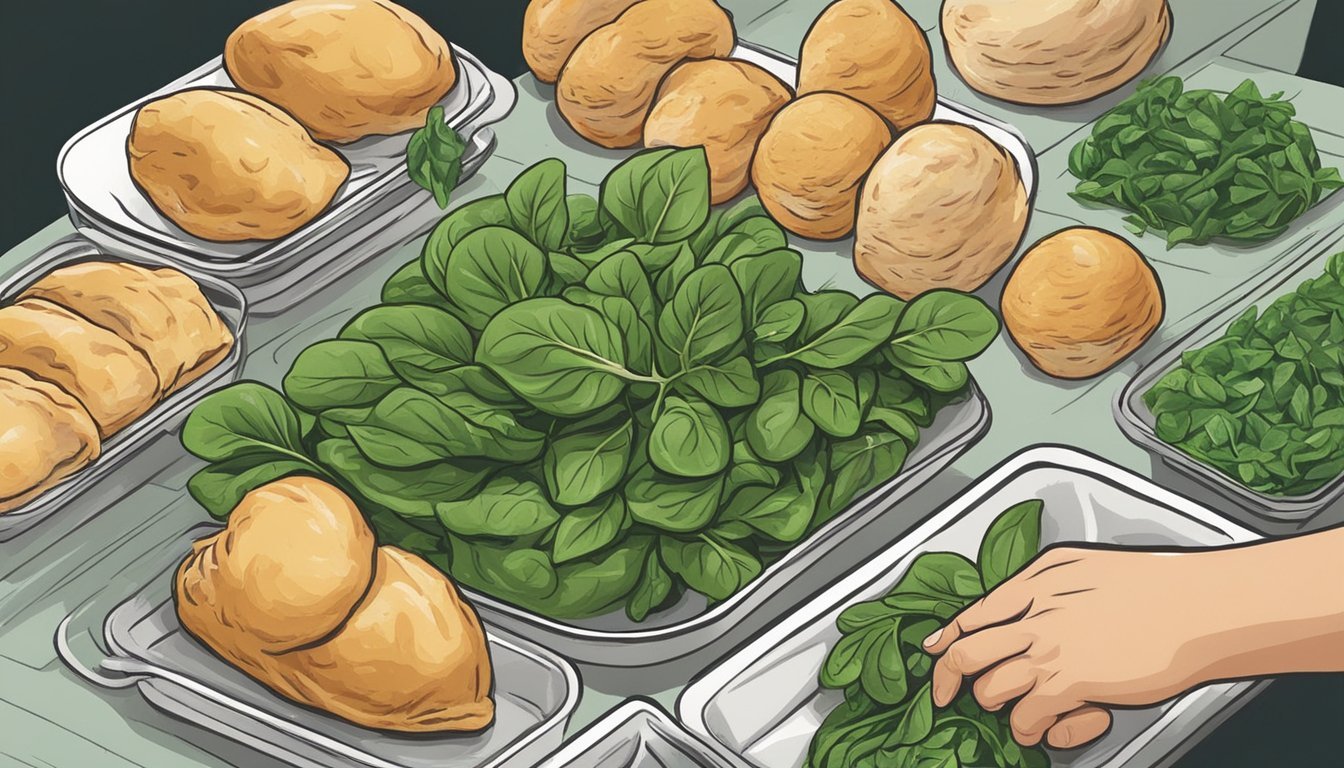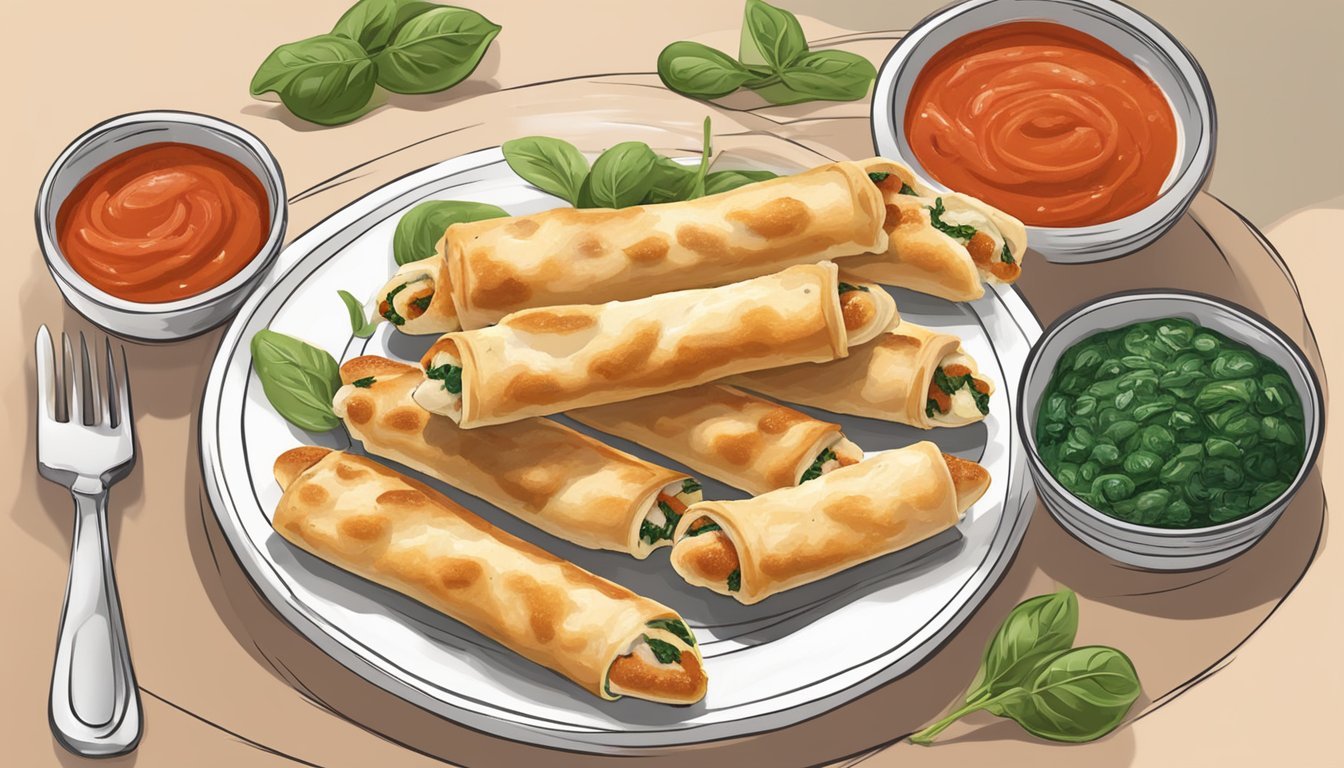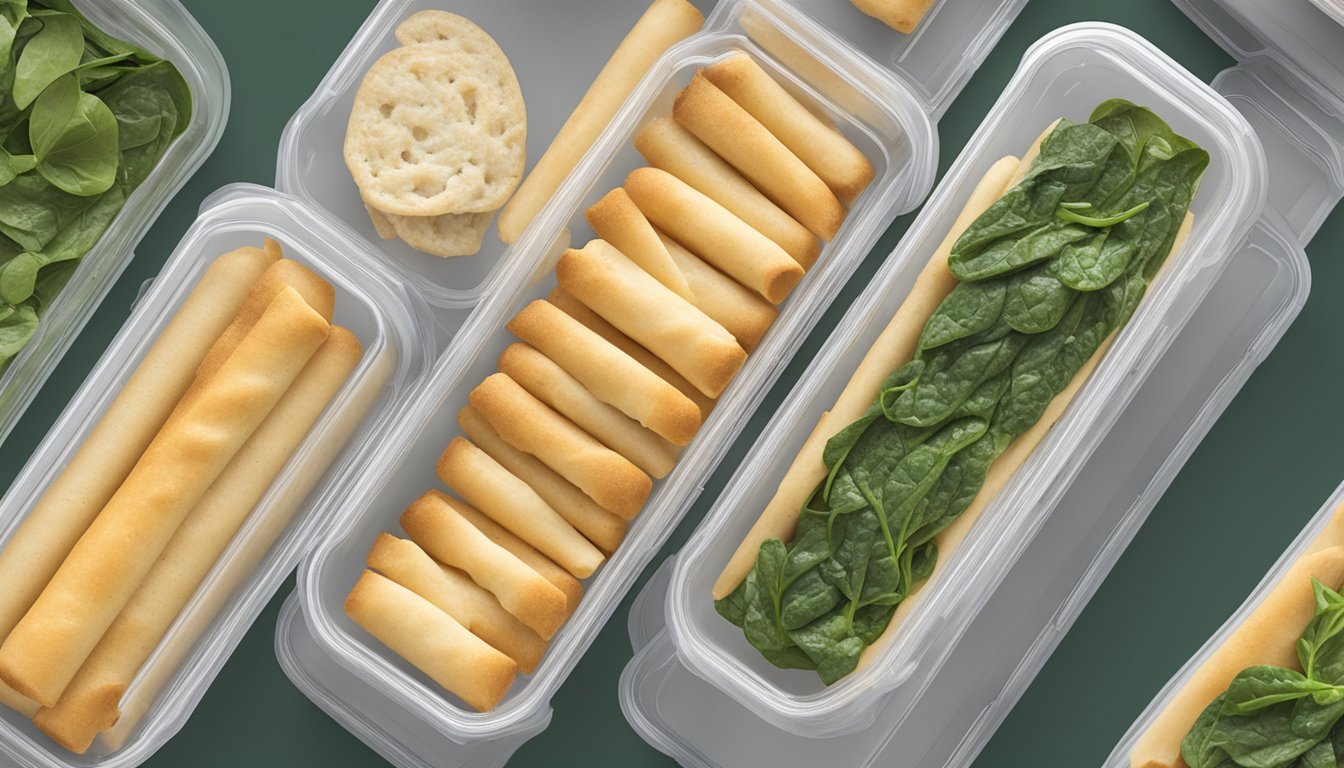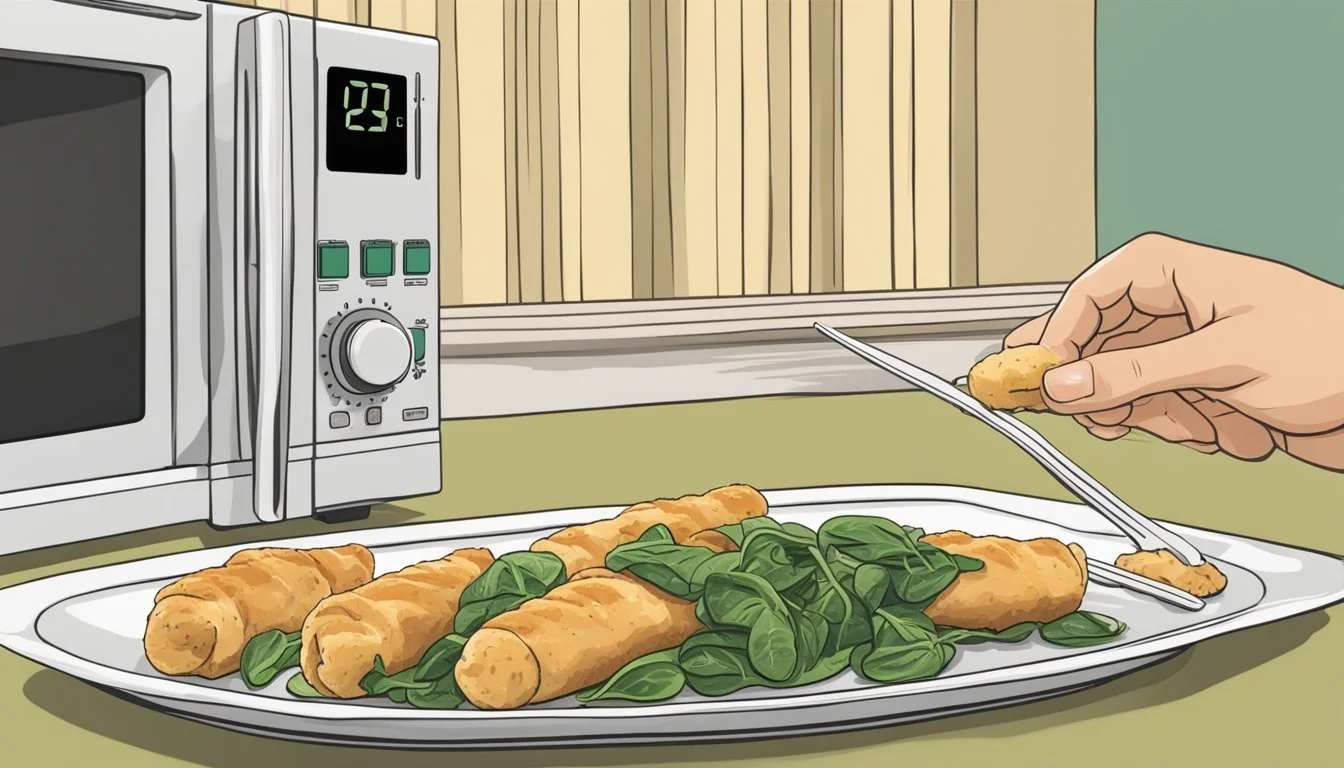How Long Do Chicken and Spinach Stuffed Breadsticks Last?
Storage and Freshness Guide
Chicken and spinach stuffed breadsticks are a delightful treat that combines tender chicken, nutritious spinach, and gooey cheese wrapped in a warm, savory breadstick. Properly stored, these delicious breadsticks can last up to 3-4 days in the refrigerator. This makes them a convenient option for meal prepping or planning ahead for busy weeks.
It's important to ensure they are stored in an airtight container to maintain their freshness. For longer storage, freezing them is an excellent option. When frozen, they can last for up to 2 months, providing a quick and tasty snack or meal that requires minimal effort to reheat.
Understanding the shelf life of these stuffed breadsticks not only helps in reducing food waste but also ensures that you enjoy their flavors at their best. Whether preparing for a family gathering or simply stocking up for the week, knowing how long these treats last is essential for optimal taste and safety.
Overview of Stuffed Chicken Breadsticks
Stuffed chicken breadsticks combine the rich flavors of seasoned chicken and spinach with melted cheese, all encased in a crispy breadstick. This section dives into what makes these breadsticks unique and explores different variations that are popular.
Definition and Concept
Stuffed chicken breadsticks feature a blend of chicken, spinach, and cheese rolled into yeast-based dough. Typically, the chicken is cooked and mixed with sautéed spinach and a variety of cheeses, such as mozzarella or cream cheese.
The breadsticks are then baked until golden brown, giving them a crispy exterior while maintaining a soft, flavorful inside.
These breadsticks serve as a versatile dish, easily fitting into a meal plan as an appetizer, snack, or even a main course.
Popular Variations
Several variations of stuffed chicken breadsticks cater to diverse tastes. Cheese-filled breadsticks might include combinations like cheddar and parmesan for a sharper flavor.
Herbs like basil or oregano are sometimes added to the filling for an Italian twist.
A spicy variant might include pepper jack cheese and red chili flakes to add heat.
Some recipes also suggest adding mushrooms or sun-dried tomatoes for additional texture and flavor, making these breadsticks even more appealing. These variations ensure that there's something for everyone's palate.
By understanding these elements, cooks can experiment or stick to classic preparations of these delightful breadsticks. The possibilities are wide-ranging, offering numerous opportunities to customize based on personal preferences.
Nutritional Profile
Chicken and spinach stuffed breadsticks offer a variety of essential nutrients. They provide a good balance of macronutrients and are rich in certain vitamins and minerals important for maintaining health.
Macronutrient Breakdown
Calories: Chicken and spinach stuffed breadsticks contain approximately 300-400 calories per serving, depending on ingredients and portion size.
Protein: These breadsticks are a good source of protein, with around 25-30 grams per serving due to the chicken and cheese used in the filling.
Fat: The fat content varies; it typically ranges from 15-20 grams per serving. The fat includes some saturated fat from the cheese and olive oil used.
Carbohydrates: They contain around 25-30 grams of carbohydrates, mostly from the bread. The fiber content is relatively low, usually around 2-3 grams per serving.
Vitamins and Minerals Content
Vitamin A: The spinach in the breadsticks is a good source of Vitamin A, contributing to eye health and immune function.
Vitamin C: Spinach also provides some Vitamin C, though the cooking process can reduce its levels.
Calcium: The cheese adds a significant amount of calcium, supporting bone health.
Iron: Spinach contributes iron, which is vital for blood health.
Sodium: Sodium content can be high, around 800-1000 mg per serving, due to added salt in the cheese and bread.
Potassium: Spinach and chicken provide potassium, important for heart and muscle function.
These breadsticks deliver both taste and nutritional benefits, making them a balanced option for meals or snacks.
Ingredient Selection
When making chicken and spinach stuffed breadsticks, it's crucial to choose high-quality ingredients to enhance taste and texture. Focus on selecting fresh chicken breasts, different types of spinach, a variety of cheeses, and the right blend of seasonings.
Choosing Quality Chicken
Opt for boneless, skinless chicken breasts for ease of preparation and cooking. These cuts are widely available and offer a lean source of protein. Ensure the chicken is fresh; look for pale pink flesh without any strong odors.
If possible, choose free-range or organic chicken as these often have better flavor and texture. To prepare, trim any excess fat and tenderize the breasts to ensure even cooking.
Types of Spinach
For this recipe, using fresh spinach provides the best texture and flavor. Look for bright green, crisp leaves without any wilting or yellowing.
Frozen spinach is a convenient alternative. It’s typically pre-washed and chopped, reducing prep time. Ensure it is thoroughly drained and excess moisture removed before use to avoid soggy filling.
Chopped spinach offers a finer texture ideal for mixing with cheese and seasonings, ensuring even distribution in the filling.
Selecting Cheeses
A combination of cheeses can elevate the flavor of the breadsticks. Mozzarella cheese provides a mild, creamy texture that melts well.
Parmesan cheese adds a sharp, nutty flavor that complements other ingredients.
Cream cheese gives the filling a rich, smooth consistency that binds everything together. It’s important to use high-quality cheeses to avoid a greasy or overly watery filling.
Seasonings and Spices
Seasonings are key to enhancing the overall flavor profile. Use kosher salt for an even distribution of saltiness without overpowering the other flavors.
Fresh garlic minced finely can impart a robust taste, while garlic powder offers a more subtle, even flavor.
Add depth with onion powder and a hint of heat with black pepper. Paprika can be used for a smokey undertone.
Drizzle a bit of extra virgin olive oil to keep the filling moist and add a hint of fruitiness to the palette. Having a balanced selection of spices ensures a well-rounded and flavorful stuffing.
Preparation Techniques
Proper preparation is crucial for ensuring that chicken and spinach stuffed breadsticks are both delicious and safe to eat. Key aspects include cleaning and cutting the chicken and assembling the stuffing.
Cleaning and Cutting
Cleaning and cutting the chicken correctly are essential first steps. Begin by washing the chicken breasts under cold running water and patting them dry with paper towels. This reduces excess moisture, ensuring better texture during cooking.
Next, place the chicken on a clean cutting board. Use a sharp knife to butterfly the chicken breasts. To do this, hold the breast steady with one hand and make a horizontal cut through the middle, opening it like a book. This creates a pocket for the stuffing.
Ensure all utensils, including the knife and cutting board, are sanitized before and after use to avoid cross-contamination.
Stuffing and Assembly
Stuffing and assembling the breadsticks require careful attention to detail. First, prepare the spinach and cheese mixture. Heat a skillet over medium heat with a tablespoon of olive oil. Add baby spinach and cook until wilted, then mix with feta or mozzarella cheese and season as desired.
Spread the spinach and cheese filling evenly inside the butterfly-cut chicken breasts. Secure the edges with toothpicks to keep the stuffing intact during cooking.
Preheat the oven to 400°F. Place the stuffed chicken on a baking sheet lined with parchment paper. Use a brush to coat the chicken lightly with olive oil, then season with a mix of salt, pepper, garlic powder, and paprika.
Cook until the internal temperature reaches 165°F, checking with a thermometer to ensure it is thoroughly cooked.
Cooking Steps and Times
Proper preparation of chicken and spinach stuffed breadsticks ensures they are flavorful and safe to eat. Key steps include marinating the chicken, cooking the spinach, and oven baking.
Marinating Chicken
Marinating chicken breast is crucial for flavor and juiciness. Use a simple marinade of olive oil, garlic, salt, and pepper. Let the chicken marinate in the refrigerator for at least 30 minutes, but no more than 2 hours to avoid a mushy texture.
Ensure each chicken breast is fully coated. For best results, butterfly the chicken so it can absorb the marinade evenly. Pat the chicken dry before using it in the stuffing process.
Cooking Spinach
Spinach should be cooked to a wilted consistency before it is stuffed into the breadsticks. Heat a medium skillet over medium-high heat and add a tablespoon of olive oil. Add fresh or thawed and drained frozen spinach to the skillet.
Saute the spinach until it is fully wilted, about 3-4 minutes. Stir frequently to ensure even cooking. Remove from heat and let the spinach cool slightly before incorporating it into the stuffing mixture. This step ensures the spinach blends well with other stuffing ingredients.
Oven Baking
Preheat the oven to 375°F (190°C) for optimal baking. After stuffing the chicken and spinach into the breadsticks, place them on a baking sheet lined with parchment paper. Secure the openings with toothpicks to keep the stuffing from spilling out during baking.
Bake the stuffed breadsticks for 20-25 minutes, or until the internal temperature of the chicken reaches 165°F (74°C). Use a meat thermometer to check the temperature at the thickest part of the chicken to ensure proper doneness. Allow the breadsticks to cool for a few minutes before serving.
Serving Suggestions
Spinach and chicken stuffed breadsticks are versatile and can be paired with a variety of side dishes to enhance their flavors. Additionally, presentation plays a crucial role in making the meal visually appealing.
Appropriate Side Dishes
Pairing spinach and chicken stuffed breadsticks with the right side dishes can elevate the meal. A Caesar salad with crisp romaine, parmesan cheese, and a tangy dressing provides a refreshing contrast. Roasted vegetables, such as Brussels sprouts or sweet potatoes, offer a robust and earthy element that complements the savory breadsticks.
Herb and garlic mashed potatoes are another excellent choice, adding a creamy and aromatic touch. Steamed rice with herbs can provide a simple yet flavorful companion, while a cucumber and watermelon feta salad introduces a sweet and tangy note perfect for summer lunches.
Marinara sauce served on the side allows for dipping and adds an Italian flair, making the breadsticks a substantial and enjoyable meal.
Presentation Ideas
Visual appeal can transform a meal. Serving spinach and chicken stuffed breadsticks on a large wooden platter can create a rustic and inviting presentation. Arrange the breadsticks neatly, and garnish with fresh herbs like parsley or basil to add a pop of color.
For a more sophisticated look, place the breadsticks in a basket lined with a checkered napkin. Small bowls of quesadillas and marinara sauce can be strategically placed around the breadsticks for added variety and dipping options.
Use white plates for a clean, elegant presentation, and consider adding a small side salad or roasted vegetables on the same plate to create a balanced and visually appealing meal. Placing a few slices of fresh cucumber or a sprig of mint can also enhance the overall look, making the dish not just delicious but also delightful to the eyes.
Storage Recommendations
To ensure that chicken and spinach stuffed breadsticks remain fresh and safe to eat, proper storage is crucial. Keeping them in the refrigerator or freezer can extend their shelf life significantly.
Refrigerating Leftovers
Store leftovers promptly. Place the breadsticks in an airtight container or tightly wrap them in aluminum foil or plastic wrap.
Ensure the refrigerator is set to 40°F (4°C) or lower. This helps inhibit bacterial growth.
Stored correctly, the breadsticks can remain fresh for up to 3-4 days. Labeling the container with the date stored can be useful in tracking their freshness.
Check for any signs of spoilage before consuming, such as changes in texture or an unusual odor.
Freezing for Long-Term Storage
For longer storage, freezing is recommended. Allow the breadsticks to cool completely to prevent moisture buildup, which can lead to freezer burn.
Wrap each breadstick individually in plastic wrap or aluminum foil to protect them. Then, place them in a freezer-safe bag or container.
Set the freezer to 0°F (-18°C) or lower. Properly stored, the breadsticks can last for up to 2-3 months.
When ready to use, thaw in the refrigerator overnight. Reheat them in the oven until golden brown and heated through. This retains the breadsticks' texture and flavor.
Reheating Instructions
To reheat chicken and spinach stuffed breadsticks, several methods can be used to ensure they remain moist and flavorful. Here are a few recommended techniques:
Oven Reheating
Preheat the oven to 350°F (175°C).
Place the breadsticks on a baking sheet.
Cover them loosely with aluminum foil to prevent drying out.
Heat for about 10-15 minutes or until the internal temperature reaches 165°F (74°C).
Microwave Reheating
Place breadsticks on a microwave-safe plate.
Cover with a microwave-safe cover or a damp paper towel.
Microwave on medium power for 1-2 minutes.
Check if they are hot enough and heat for additional time if necessary.
Skillet Reheating
Heat a non-stick skillet over medium heat.
Add a small amount of water or broth to the skillet.
Place breadsticks in the skillet and cover with a lid.
Steam for about 5-7 minutes, turning occasionally, until heated through to an internal temperature of 165°F (74°C).
Pro Tips
Always check the internal temperature with a meat thermometer to ensure food safety.
Avoid reheating multiple times as it can dry out the breadsticks.
For added flavor, consider brushing the breadsticks with a bit of olive oil or butter before reheating.
Food Safety Considerations
By ensuring proper cooking techniques and safe handling practices, foodborne illnesses can be prevented when preparing and storing chicken and spinach stuffed breadsticks.
Understanding Safe Internal Temperatures
Cooking chicken to a safe internal temperature is crucial. Chicken must reach 165°F (74°C) when checked with a food thermometer. This ensures harmful bacteria such as Salmonella are eliminated. Spinach should also be cooked thoroughly, though the focus remains on the chicken.
If using pre-cooked chicken, reheat it to at least 165°F. Use a clean thermometer to check temperatures. Avoid guesswork; precision is key.
Preventing Contamination
Preventing cross-contamination is vital. Always wash hands, utensils, and surfaces after handling raw chicken. Store raw and cooked foods separately to avoid cross-contact.
Refrigerate unused portions promptly at 40°F (4°C) or cooler, using airtight containers to extend freshness. Consume within 3-4 days, as USDA guidelines recommend for cooked chicken storage. This ensures the stuffed breadsticks remain safe to eat while maintaining quality.
Health and Dietary Information
Chicken and spinach stuffed breadsticks can be a nutritious addition to your diet if prepared with healthy ingredients and mindful cooking methods. This section addresses how they can be adapted for various dietary restrictions and how to balance them within a healthy diet.
Dietary Restrictions Adaptations
For individuals who need to follow a gluten-free diet, using gluten-free bread or alternative flours can help make chicken and spinach stuffed breadsticks suitable. Opt for gluten-free breadcrumbs or almond flour for breading.
Those on a low-carb diet might replace traditional bread with low-carb alternatives such as cauliflower-based breadsticks. This reduces carbohydrate intake significantly while maintaining flavor and texture.
For lactose-intolerant individuals or those avoiding saturated fat, substituting dairy-based ingredients with lactose-free or low-fat cheeses can help. Replace regular cream cheese with low-fat or lactose-free versions, and use olive oil instead of butter to minimize saturated fat.
Balancing the Meal for a Healthy Diet
Balancing chicken and spinach stuffed breadsticks involves focusing on key nutrients. Protein from the chicken is crucial for muscle repair and growth, making these breadsticks an excellent protein source.
Selecting spinach as a filling adds vital vitamins and minerals, including iron, calcium, and vitamins A and K, ensuring nutrient density.
Caloric control is important. Limit portion sizes and use whole grain or low-carb breadsticks to manage calorie intake. Adding a side of mixed vegetables can create a well-rounded meal.
Aim for healthy fats by incorporating extra virgin olive oil for cooking instead of butter, reducing unhealthy saturated fats and promoting heart health.
By making these mindful ingredient choices, chicken and spinach stuffed breadsticks can fit into various dietary plans while offering a nutritious and delicious option.












